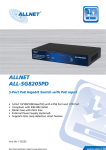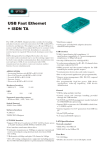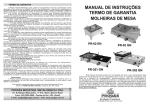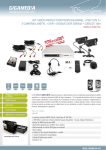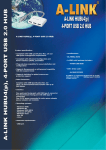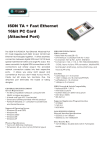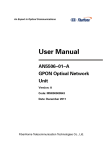Download Sitecom ISDN USB Adapter
Transcript
Data sheet: DC-104 DC-104 ISDN USB Adapter 8716502002658 0/20 To be rated To be rated 352g 240 (L) x 170 (W) x 180 mm (H) 7,7 kg. 650 (L) x 430 (W) x 310 mm (H) The ISDN USB adapter is connected via the USB port of the computer. A major advantage of this device is that the activity and status of the ISDN line(s) are clearly shown by means of LED indicators. ISDN USB Adapter driver CD Application software CD Manual USB Cable Telephone cable Win98 Win2000 Win-Me Win-XP P. 1-2. Data sheet: DC-104 128 Kbps transfer rate Including RVS Com Lite for e.g. communication port simulation, fax transmission and reception, digital answering machine, data communication, analogue modem simulation Suitable for Windows 98/2000/ME/XP. Technical specifications: Hardware Interface ISDN S/T USB LED Power: B1, B1 OS Windows 98/SE ,2000, ME and XP Switch Protocol DSS1: Euro-ISDN Software Interface CAPI 2.0 ISDN WAN Miniport S/T ISDN Interface Support OSI level 1 conform to UIT-T I.430 for basic access at S and T interfaces (ETSI 300012/ANSI T1.605) Line interface transformer direct drive 2 B channels at 64kbps each plus 1 D channel at 16kbps All I.430 wiring configurations supported including passive bus for TE’S distributed point to point and point to multipoint Multiframe support Analog part: included with adaptive detection threshold and equalizer USB Interface USB 1.0 specification full compliance, 1.1 specification compatibility (1.1 power management compliance), 12 Mbps full speed On-chip USB transceiver with digital PLL 6 isochronous endpoints for B1, B2 ,D channels data. Interrupt endpoint for I430 ISDN protocol and data.control endpoint for USB Communication device class and vendor requests Bus or self powered application (pin programmable) Onnow power management (D0, D2, D3) suspend mode compliance Pin programmable high/low power USB device Registration, wake-up capability, USB device identification Typical power consumption: Operating state 80 mA Idle state 40mA Sleep mode 0.5 mA P. 2-2.



